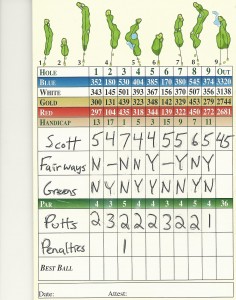Many golfers get more enjoyment from hitting their driver than any other club in their bag. The distance, sound and feel from crushing a ball with your driver is unmatched by any other club. But with the thrill that comes from hitting your driver, there comes a huge amount of responsibility. There is no other club that can take you out of a hole as quickly as the driver can. Some high handicap golfers will avoid using their driver. I disagree with never using your driver. You’ll benefit from the length and it will be the correct club off the tee on several holes during a round. Every golfer needs to be comfortable hitting their driver off the tee.
Since most courses do not have a par 3 as their opening hole, there’s a decent chance driver will be the right choice off the first tee. It’s very important that you warm up and get loose at the practice range before you start your round. Remember time on the practice range before a round is warm up time and not practice time. You shouldn’t work on your swing during warm up time before a round. If you do not have time to hit the range before a round, make sure you thoroughly stretch and take plenty of practice swings. I know for me personally that there’s a good chance I will pull my drive left off the tee if I am not properly warmed up and loose.
You are allowed to tee up your ball anywhere between, but not in front of, and up to two club lengths behind the tee markers on the tee box. There is a preferred side to tee off from but it is more important that you tee off from a flat area. This is not an issue on many courses as the tee area is completely flat. However, there are some courses I like to play that have at least a few unleveled tee boxes. You have a huge benefit starting each hole being able to tee up your ball. The last thing you want to do is give yourself an uneven lie!
Provided you have a flat area, you want to tee off from the same side of the tee box as the trouble you are trying to avoid is. It’s simply easier to hit away from the trouble by teeing up on the same side it is on.
I see a lot of amateurs who do not account enough for the wind during their round. Granted a driver is not going to be affected as much as a wedge shot, but many of us get more air under our drives than we should so they are still going to be affected by the wind. Be sure to check the wind direction and strength before your shot and take it into consideration while lining up.
You’ll need a consistent pre-shot routine before every shot, especially your drives. A consistent routine of visualizing your drive, taking a practice swing and correctly lining up your drive will help you hit more fairways.
Your driver is one of the most used clubs in your bag. Learning to consistently hit the ball in the fairway off the tee with your driver is crucial to avoiding trouble and scoring well on the hole.




